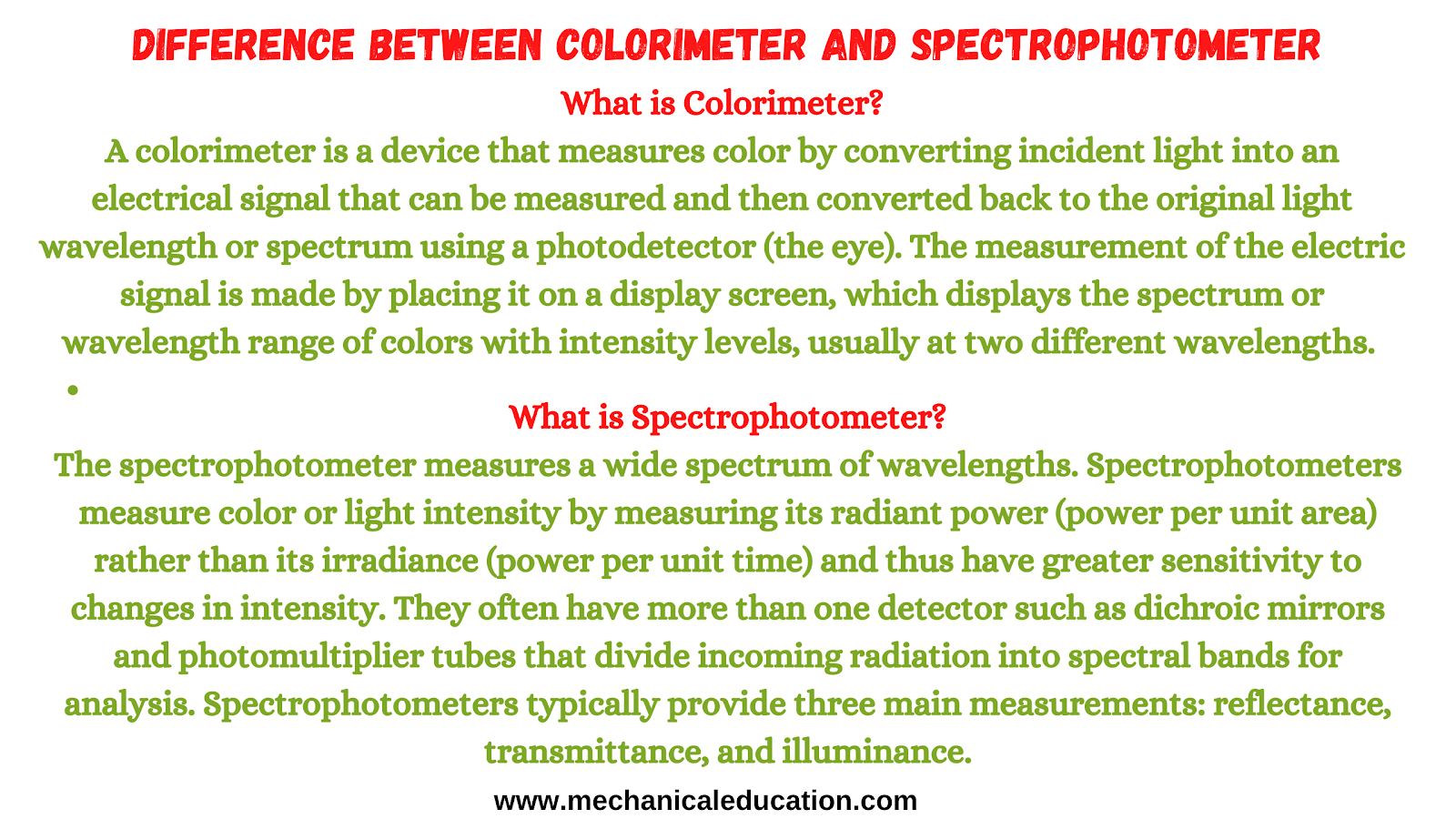Difference Between Colorimeter and Spectrophotometer:
Colorimeter and spectrophotometer are instruments used for measuring the color of light. They are similar in function but different in application.
What is Colorimeter?
A colorimeter is a device that measures color by converting incident light into an electrical signal that can be measured and then converted back to the original light wavelength or spectrum using a photodetector (the eye). The measurement of the electric signal is made by placing it on a display screen, which displays the spectrum or wavelength range of colors with intensity levels, usually at two different wavelengths.
The colorimeter measures the intensity of a single wavelength.
What is Spectrophotometer?
The spectrophotometer measures a wide spectrum of wavelengths. Spectrophotometers measure color or light intensity by measuring its radiant power (power per unit area) rather than its irradiance (power per unit time) and thus have greater sensitivity to changes in intensity. They often have more than one detector such as dichroic mirrors and photomultiplier tubes that divide incoming radiation into spectral bands for analysis. Spectrophotometers typically provide three main measurements: reflectance, transmittance, and illuminance.
Difference Between Colorimeter and Spectrophotometer?
A Colorimeter is a device that measures the intensity of light. A spectrophotometer is a device that measures the amount of light energy in a sample and then converts it into units such as volts or milliwatts.
A Colorimeter is a device that measures the amount of light emitted by a substance. The colorimeter is limited to determining one signal property – such as absorbance or luminescence.
A Spectrophotometer is an instrument used to measure the absorption and reflection of light at different wavelengths. The spectrophotometer can produce analytical data that include constituent wavelength and its corresponding intensity value. Spectrophotometers can also measure the light that has been polarized (orientation).
Spectrophotometers: these devices work by shining a narrow band of light (usually red, green, and blue) through the unknown and measuring the amount of light that is either passed or absorbed. The result is expressed in wavelength units such as nanometers (nm), micrometers (µm), or simply watts per steradian.
Colorimeters: These provide a direct color measurement with readings on a scale from zero to 100. These are useful for verifying the accuracy of analytical instruments such as chemical analyzers and pH meters. For example, they can be used to check whether an instrument is performing within stated tolerances of error by comparing its output with the known absorbance spectrum
Spectrophotometers are more versatile while colorimeters are used for determining colors precisely.
A Colorimeter is a non-dispersive device for measuring or estimating the color of a material. They are typically used in materials selection for dyeing flame-proofed textiles and other areas where precise color matching is crucial. In contrast, a spectrophotometer cannot be used as a reliable measure of colors but they can indeed measure the concentration of substances such as those found in water that has been measured to determine physical properties such as pH level.
Spectrophotometers measure the absorption of light in a certain wavelength range. This ranges from visible wavelengths to something outside the visible wavelength spectrums. Colorimeters, on the other hand, are more limited to measuring. A colorimeter can’t be used for any analysis that requires quantitative measurement of absorption or transmission of light at different wavelengths within two broad spectral bands. Whereas spectrophotometers can be used with an accessory called a slit aperture which allows spectra analysis by different wavelengths instead of just looking at the brightness spectrum-a colorimeter cannot do this without attachments/accessories.
Spectrophotometers offer more options for measurement than colorimeters because they can analyze spectral wavelengths and polarization orientation against any combination of incident and transmitted light sources.
Spectrophotometers give More Output Data, More Analytical Options, Better Analysis, Greater Capabilities.
A Colorimeter is a device used to measure the color of a material. A spectrophotometer is a device used to measure the amount of light that is transmitted, reflected, or scattered by a material.
A Colorimeter is a device used to measure the color of a material. It works by shining light of a known wavelength through the material and then measuring the intensity of the light that is reflected. This intensity is then used to calculate the color of the material.
A Colorimeter is used to measure the intensity of light at a given wavelength, while a spectrophotometer measures the percent of light transmitted at a given wavelength.
Colorimeter and Spectrophotometers measure the amount of light that is passed through or reflected off of a sample.



